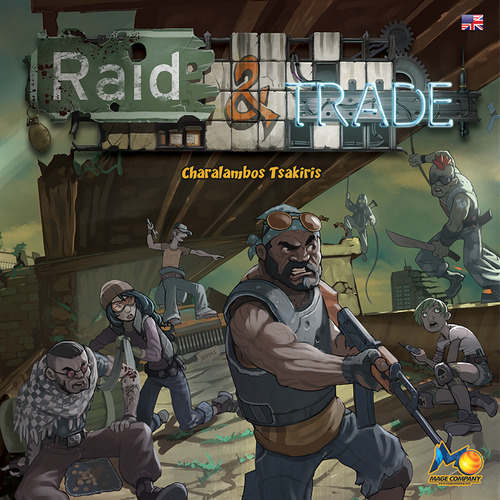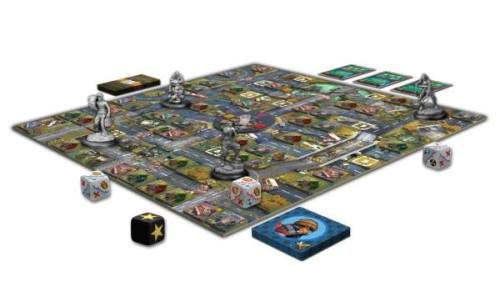When I first heard the words “post-apocolyptic” to describe this game, I thought I knew what to expect. I mean, most of the post-apocolyptic games I’ve been playing as of late involve zombies…not that I’m complaining. “Raid & Trade”, I’m pleased to report, is somewhat different. Rather than fight against zombies and/or infected, you’ll be competing against other players. Your goal? Scavenge up enough to be allowed access to the Golden City, a place where the privileged few have banded together to rough out these harsh times. Before we take a look at what this game has to offer, I’d like to thank Alexander Argyropoulos from Mage Company LTD for reaching out and providing me with a copy of the rulebook (due to International shipping costs). As such, this preview will be focused more on my impressions of the rules based on what I’ve read. It’s also important to note that the game is seeking funding through the Kickstarter process (as of 11/03/14), making everything you see here (components, rules, etc.) subject to change.
“Raid & Trade”, if I were to sum it up, is all about character building, resource collection, and player interaction. At the beginning of the game, players will set up the map appropriately, the layout of which will change depending on how many people are playing the game. The map will mainly consist of main roads, side roads, and alleys. Players will be visiting these locations to explore and “raid” the buildings located there. Upon raiding a location, a raid card is drawn to determine what scenario will be played out. Depending on the players’ responses, they’ll earn “malevolence” and/or “benevolence” points (like a Karma system) among other things. Eventually players will grow their characters and earn themselves enough resources to make it into the Golden City and win the game!
Of course, there’s a lot more to it than that. The Golden City won’t just take any resource you manage to scrounge up. Rather, they’ll request a specific set of resources or skills via “radio message cards”. For example, one card might request 10 Skill Mechanic AND 5 Medical Equipment. Some cards feature the conjunction “or”, giving players a bit more freedom to satisfy these objectives. Interestingly enough, these messages can change throughout the game through various means. This will certainly keep players on their toes as they struggle to keep up with the ever-changing demand.
The flow of gameplay is kept in check with the action point system, forcing players to consider the choices they make on their turn. Moving to main roads, side roads, and alleys, for example, all have different action point costs. You can use action points to raid a location or even attack another player in an attempt to steal some of their hard-earned resources. Speaking of resources, there are many different types with varying effects. Food, for example, may allow players to regain action points. Some resources can even be crafted together to form a better item with special abilities. A player’s chosen skill (medic, trader, etc.) can be improved this way as well, which is tracked via a separate counter.
The global event deck makes things even more hectic, though they serve a number of different purposes depending on the card in question. Some will help a specific player while other cards affect the entire game. Acquiring one can be done so at the end of a round by paying an action point. Doing so might be worth your while, as some remain as persistent buffs throughout the rest of the game. Once a map has expired (all the buildings have been raided), you’ll have to give the non-permanent cards back before starting a new one, so don’t sit on these for too long!
Combat looks to be fairly simple in that you’ll be relying on the die rolls to determine who wins. This overly simplistic system seems to be both a boon and a curse. I’m all for combat systems that don’t require eight pages to understand, but it’s very easy to lose your resources due to some really bad luck/die rolls. Luckily, attacking another player costs seven action points and you’ll gain benevolence in the process. Winning in combat will yield either fixed or random resources, depending on how the losing player wants to proceed. Generally, the winner will get more resources with the random option, but may get a great card guaranteed when given the ability to choose.
“Raid & Trade” reminded me of my “Fallout” days a bit, what with the loot collection and character progression. It was also refreshing to see a post-apocolyptic setting that doesn’t involve the undead trying to devour my brain. I also thought that the “karma” system was a nice touch. I’ve always enjoyed watching my character change as a result of my choices in games like “Mass Effect” and “Star Wars: Knights of the Old Republic”, so it was cool to see something similar here. There’s also a cooperative element to the game that I find appealing, even though only one of the players will be allowed entry into the city. Those of you enjoyed playing “The Lost Dutchman”, another tile exploration/character development board game, might enjoy this one. At the very least, it’s worth checking out.
—
You can learn more about and support “Raid & Trade” by visiting its Kickstarter page, here:
https://www.kickstarter.com/projects/magecompany/raid-and-trade


